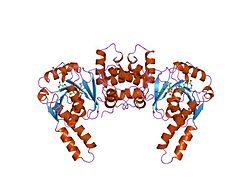Clinical significance
Mutations in this gene cause one form of familial hyperinsulinemic hypoglycemia. [10] A deficiency is associated with 3-hydroxyacyl-coenzyme A dehydrogenase deficiency. Mutations also cause 3-hydroxyacyl-CoA dehydrogenase deficiency. There are a wide variety of mutations that have been identified to cause this disease. Among them are missense mutations (A40T, P258L, D57G, Y226H) and nonsense mutations (R236X) in the protein, and splicing mutations (261+1G>A, 710-2A>G) and some small deletions (587delC) in the cDNA. [11] One mutation, 636+471G>T in the HADH gene, was shown to create a cryptic splice donor site and an out-of-frame pseudoexon. [12] Most of the described cases have homozygous mutations. This disease has fairly homogenous clinical presentation across cases. The symptoms first appear in early life, between 1.5 hours post birth and 3 years of age, and the most common symptoms are hypoglycemia and seizures/convulsions directly related to the hypoglycemia. There are other clinical presentations that have been identified, namely: myoglobinuria, dicarboxylic aciduria, feeding difficulties in infancy, muscular hypotonia, hepatic steatosis, growth delay, hypertrophic cardiomyopathy, dilated cardiomyopathy, hepatic necrosis, and fulminant hepatic failure. The disorder may be diagnosed by either the analysis of the molecular genetics of the individual, or by detection of abnormal metabolite levels in blood and/or plasma. Individuals with this deficiency have an elevated amount of 3-hydroxyglutarate excreted through the urine; a heightened level of C4-OH acylcarnitine in the blood plasma is also a characteristic of this FAO disorder. Most documented cases thus far have shown that individuals are responsive to diazoxide treatment, and highlight the need for diagnosis and treatment administration as early as possible in order to correct hypoglycemia and avoid irreversible brain damage. [11]
This page is based on this
Wikipedia article Text is available under the
CC BY-SA 4.0 license; additional terms may apply.
Images, videos and audio are available under their respective licenses.















